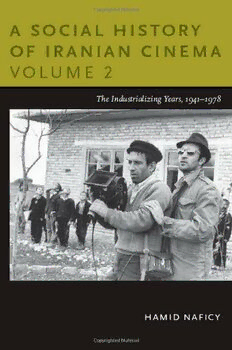
A Social History of Iranian Cinema, Volume 2: The Industrializing Years, 1941–1978 PDF
Preview A Social History of Iranian Cinema, Volume 2: The Industrializing Years, 1941–1978
a social history of iranian cinema Volume 1: The Artisanal Era, 1897–1941 Volume 2: The Industrializing Years, 1941–1978 Volume 3: The Islamicate Period, 1978–1984 Volume 4: The Globalizing Era, 1984–2010 praise for A Social History of Iranian Cinema “Hamid Naficy is already established as the doyen of historians and critics of Iranian cinema. Based on his deep understanding of modern Iranian political and social history, this detailed critical history of Iran’s cinema since its found- ing is his crowning achievement. To say that it is a must-read for virtually all concerned with modern Iranian history, and not just cinema and the arts, is to state the obvious.” —h oma katouzian, author of The Persians: Ancient, Mediaeval and Modern Iran “This magisterial four-volume study of Iranian cinema will be the defining work on the topic for a long time to come. Situating film within its sociopoliti- cal context, Hamid Naficy covers the period leading up to the Constitutional Revolution and continues after the Islamic Revolution, examining questions about modernity, globalization, Islam, and feminism along the way. A Social History of Iranian Cinema is a guide for our thinking about cinema and society and the ways that the creative expression of film should be examined as part of a wider engagement with social issues.” — annabelle sreberny, co-author of Blogistan: The Internet and Politics in Iran “A Social History of Iranian Cinema is an extraordinary achievement, a schol- arly, detailed work in which a massive amount of material is handled with the lightest touch. Yet it is Hamid Naficy’s personal experience and investment that give this project a particular distinction. Only a skilled historian, one who is on the inside of his story, could convey so vividly the symbolic significance of cinema for twentieth-century Iran and its deep intertwining with national culture and politics.” — laura mulvey, author of Death 24× a Second: Stillness and the Moving Image “Hamid Naficy seamlessly brings together a century of Iran’s cinematic history, marking its technological advancements and varying genres and story- telling techniques, and perceptively addressing its sociopolitical impact on the formation of Iran’s national identity. A Social History of Iranian Cinema is essential reading not only for the cinephile interested in Iran’s unique and rich cinematic history but also for anyone wanting a deeper understanding of the cataclysmic events and metamorphoses that have shaped Iran, from the pivotal Constitutional Revolution that ushered in the twentieth century through the Islamic Revolution, and into the twenty-first century.” — shirin neshat, visual artist, filmmaker, and director of the film Women Without Men A Social History of Iranian Cinema volume 2 Hamid Naficy a social history of iranian cinema Volume 2 The Industrializing Years, 1941–1978 Duke University Press Durham and London 2011 © 2011 Duke University Press All rights reserved. Printed in the United States of America on acid-free paper ∞ Designed and typeset in Scala by Julie Allred, BW&A Books, Inc. Library of Congress Cataloging-in-Publication Data appear on the last printed page of this book. Duke University Press gratefully acknowledges the support of the School of Communication at Northwestern University, Northwestern University in Qatar, and the School of Humanities at Rice University, which provided funds toward the production of this book. To my parents, who instilled in me the love and pleasure of knowledge and arts To my country of birth, Iran, and its extraordinary culture and history To my adopted country, the United States, and its cherished democratic ideals
